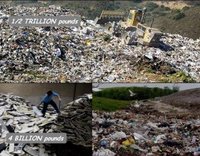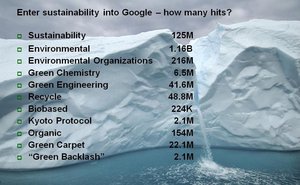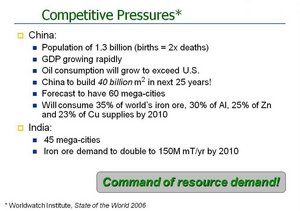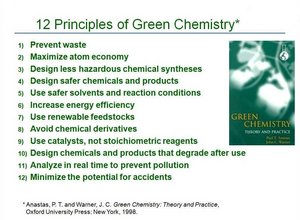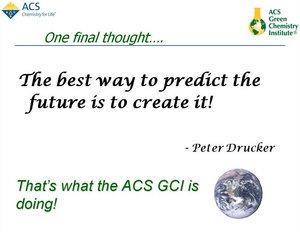Big Challenges, Big Green Chemistry Solutions
| Topics: |
This article is taken from a speech given by Robert Peoples, Ph.D. (Director, American Chemical Society, Green Chemistry Institute®) at the Annual Meeting of the Royal Society of Chemistry Annual Meeting at the British Embassy in Washington, DC on June 6, 2009.
As we embark on this presentation let us begin by realizing that mankind is on a journey to achieve a society which is sustainable. Part of the challenge we face is to truly understand what it means to be sustainable, then we must invent ways to achieve a sustainable existence. We will define this term in a few minutes, but it is important to recognize this journey is a marathon, not a sprint. We have only taken our first tentative steps and it will require the collective wisdom of many scientists, engineers, business people, environmentalists, elected officials and the public from around the world to navigate these unknown and challenging waters. But navigate them we must, for the future of mankind depends on it.
Think of the most wonderful places you have visited on vacation, on your honeymoon, or where you have lived. Remember the smell of the flowers, the crystal clear blue waters, the vista of snow capped peaks, the mustiness of the tropical rain forest. Create the vivid, colorful images along with the sounds that you so fondly remember. Now think carefully about the words you would selectively choose to describe these images to a loved one or close friend.
You truly enjoyed these places. Why – because we all have a fundamental love of nature. That love of nature is in our genes and it is captured in a term coined by Harvard Biologist Edwin Wilson – Biophilia – it literally means love of life and nature.
It is part of all of us and it is in the roots of our existence.
Now I ask you to open your eyes and let’s talk about our future.
What I am about to tell you is not meant to scare you. I do want to make you aware of some of the facts associated with the challenges we face on our journey to a sustainable future in the 21st century. More importantly, I want to share with you the critical role green chemistry will play in tackling those challenges.
This image is the famous photograph of “earth rise” from the moon taken by the crew of Apollo 8. It helps us realize just how small, fragile and finite the earthand its resources really are.
Mankind has been dabbling in chemistryfor a few thousand years. But it is only in the last 200 years or so that we have unraveled the mysteries we call chemistry. We now understand the rules by which atoms and molecules may be manipulated. It was not until Dmitri Ivanovich Mendeleev published what we consider to be the first modern Periodic Table of the Elements did pieces of the puzzle begin to fall into place.
Progress came quickly and man began to unravel the rules of nature that govern these chemical transformations. Soon it became possible for scientists to not only create molecules, but actually design new materials that did not exist in nature. Molecules which had properties that were new, different, and in many cases better. They were stronger, lasted longer, resisted breakdown in the environment, were easy to fabricate into products that made our lives easier or our free time more fun. And so we saw the advent of modern chemistry at the turn of the last century.
We also learned that petroleumwas a wonderfully versatile feedstock for the basic building blocks of this new industry. Oil was cheap, readily available and chemists were learning how to make all manner of interesting building blocks. The production of large volumes of materials became economically feasible and along with it the beginning of a growing disposal challenge – a challenge nature does not face.
Today we see the impact of what has become our “throw away society.” In 2005 the US EPA estimated that some 500 billion tons (1x1015 pounds) of municipal solid waste (MSW) were generated in the U.S. and more than 4 billion pounds (4x109) of e-waste (computers, printers, televisions, cell phones, etc.).
But, something was different about manmade chemistry. Nature, in her elegant design of materials, conducts chemical transformations at room temperature and atmospheric pressure, in water, and without waste.
Let’s look at a few examples of the elegant engineeringsolutions provided by nature. The wing of this beautiful butterflyhas a magnificent blue color. Nature creates this color not by using highly conjugated aromatic molecules and metals, but by the use of nano particles whose dimensions are on the same scale as that of the wavelengthof blue light in the visible spectrum light part of the spectrum. The lotus flower maintains a clean surface by allowing water to simply bead up and wash away dirt and dust. It does this by creating nano scale structures on the surface of its leaves resulting in a very high contact angle that repels water and causes it to run off. The feet of the geckohave now been shown to have tiny, nano scale hairs. These hairs are so small that millions of them allow intimate contact with a surface thus integrating the tiny van der Waals forces that allow the gecko to cling to surface, even when upside down. And finally, look at the shell of an Abalone. Nature has found a way to deposit minerals to create a structural material that protects the soft inhabitant that lives inside. These are all examples of elegant engineering that has evolved over millions or billions of years.
Man, in contrast, uses high or low temperatures which require energyto achieve, and the generation of that energy typically involves the burning of fossil fuels with all the associated emissions. In many cases high pressureis employed, again requiring energy. Most chemistry is conducted in organicsolvents, many of them toxic. At the end of a reaction sequence there is typically lots of waste. It is not unlikely that we produce from 5-100 pounds of waste for every pound of desired product and in some cases much more than this. In addition, many of the materials we produce are not good for human health and the environment. We are now learning that many of these materials resist degradationand thus last for a long time in the environment. We call these compounds persistent organic pollutants (POPs) and many have now been shown to accumulate in living systems. We refer to this phenomenon as bioaccumulation. Another common term is persistent bioaccumulative toxin or PBT.
Public awareness and concern for the effects of chemicals in our environment came in 1962 with the publication of the book, “Silent Spring,” by Rachael Carson. For the first time we began to fully realize the impact chemicals were having on our environment.
Clearly we knew back in the second half of the 1800’s certain dye chemicals were creating health problems, but exposures were limited to factory workers and cases were not well documented. Later issues of tobaccobecame known to the general public followed by asbestos, methyltertiarybutyl ether (MTBE) which is an oxygen-containing gasoline additive, thalidomideand birth defects, DDTand the list goes on.
We all know and appreciate that modern chemistry has dramatically improved the quality of life for all mankind and is helping to fight diseaseand feed those in developing nations and the growing population of our planetas a whole.
Dr. John Warner of the Warner-Babcock Institute charted the rise in regulations in the United States over the years 1870 through about 1995. Something significant happened in 1962 with the publication of “Silent Spring.” As awareness grew, people began to demand action and regulations and laws were enacted to protect the public from chemicals and chemical manufacturers. One need only examine the graph to see the rapid proliferation of regulations further enabled by the establishment of the United States Environmental Protection Agency (EPA) in 1970 by President Richard Nixon, the passage of the Clean Water Act in 1972 and the Toxic Substances Control Act of 1976 (TSCA). Despite all our best efforts and good progress, we are only now beginning to truly understand the delicate balance of nature and the impact of mankind, termed anthropogenic influences.
Let’s look at the explosionof information enabled by the internet and the ease of global travel over the past several years. In preparation for this lecture I went to the Google search engine and entered the word “sustainability.” I was surprised to get more than 125 million hits. So I entered additional common environmentally related terms as shown in the figure below. There are a few conclusions one can draw from this table, the first of which is, there is a lot if information and attention focused on the environment, “green” and sustainability. There is also a rising concern about false or misleading information which is generally referred to as “green washing.”
So let’s turn our attention to the developing world. Today the population of our planet is estimated at about 6.7 billion people. What is staggering is the fact that more than 1.3 billion of those people, fully 1/5 of our planetary population, do not have access to safe drinking water. Another 2.6 billion people do not have access to sanitary conditions. And the population is expected to increase by about 50% in the next 40 years.
With the advent of modern communications technology, all of these people now understand what is available in developed countries. These people want and have a fundamental human right to the same quality of life we enjoy.
It has been estimated that we exceeded the carrying capacity of the planet Earth in about 1986. In fact, we are now consuming resources at a rate which would require more than one Earth to continue at this pace. So the question is, what does sustainabilitymean and how can we achieve it?
A good, easy to understand working definition of sustainability was created by the Brundtland Commission as follows:
Meeting the needs of today without compromising the ability of future generations to meet their needs.
The United Nations convened this initiative in 1983 under the name World Commission on Environment and Development (WCED). The initiative later became known by the name of its Chair Gro Harlem Brundtland. The commission was created to address growing concerns "about the accelerating deteriorationof the human environmentand natural resources and the consequences of that deterioration for economic and social development." In establishing the commission, the UN General Assembly recognized that environmental problems were global in nature and determined that it was in the common interest of all nations to establish policies for sustainable development.
Let’s examine the impact of a rapidly expanding population and economy by looking at China. Not only does China contain about 20% of the total population of our planet, but by sheer numbers they are growing at an incredible rate. China is quickly becoming an economic power with the expectations of a population to increase rapidly the standard of living including access to high tech goods, transportation, power, etc. As the population moves to the cities looking for this improved quality of life construction is expanding at an alarming pace. China surpassed the annual release of carbon dioxide by the United States in August of 2007 and is now aggressively securing long term contracts for raw materials. In fact, it is estimated that China is starting up one new power plant every week. All of these plants are burning coalwith the associated environmental consequence and green house gas emission issues. In addition, coal-fired power plants are the largest source of mercury emission, and mercury is a known neurotoxinthat bioaccumulates.
It has been estimated that China will build something on the order of forty billion square meters of space in the next 25 years. This number is hard to put into perspective so we will come back to it in a minute.
So this rapid escalation for demand of raw materials is just for one developing nation. Coming right on the heels of China is India. While the population of India is less than that of China, it has no population control strategy and as a consequence is expected to surpass China’s growing population sometime in the next 30-40 years. This escalating growth does not take into account the African Continent or South America. You can see the demand and control of valuable raw materials and resources will create security, logistical and economic pressures never seen on this planet in the past. The consequences will be significant.
Let’s come back to the issue of forty billion square meters of new construction. The largest building under one roof is the U.S. Pentagon, located in Arlington, Virginia. The Pentagon has more than 6.5 billion square feet of space (~0.6 million square meters). So, to put forty billion square meters into perspective, China will build more than 67,000 new pentagons in the next 25 years. Think about the materials they will need including: cement, steel, glass, plumbing, wiring, paint, flooring, window treatments, heating and air conditioning, furniture, lighting, etc. These quantities of material and the associated manufacturing and waste impacts are staggering and help define the scope of the sustainability challenge we all are facing.
It will take real vision and leadership. Back in 1970, then President Richard Nixon articulated a vision that would have changed the course of history and positioned the United States to be energy independent. Unfortunately he was not a leader because he did not follow through on this vision and the first oil embargo occurred a few years later.
In fact, I believe the last great leader was John F. Kennedy who on January 25, 1961 challenged the people of his country to put a man on the moon and bring him back safely before the end of the decade. While Kennedy did not live long enough to see his vision fulfilled, he put in place the systems and support that made that dream a reality. Clearly the people of this planet are better off today as a result of that vision and the inventions, innovations and technology that resulted. We call it technology spin-off.
I have been asked what will be the consequences of the current global economic crisis. The short answer is a delay on our journey to a sustainable future. It takes money to develop and implement new technology and money is tight right now. The impact will be more analogousto a series of speed bumps in the road. It will cause us to slow down, but will not divert us from the journey. There are those who might use the economic situation as an excuse to stop or delay investment in green chemistry and new technologies. However, history shows that those who take advantage of such a slow down are well positioned when the economy turns around.
When we think about the challenges we face, it is very clear there has never been a better time to be a green chemist or engineer. Energy is fundamental to all we do and just 93 billion miles away sits a limitless and free source of energy, the sun. Imagine this; our sun delivers enough energy in a single hour to meet all the power needs of this planet for a full year. We must invest in the development of higher efficiency solar energy systems, be they photovoltaicor thermalin nature, while at the same time making sure the new materials and manufacturing systems are designed using the principles of green chemistry to avoid the generation of hazardous substances.
As we discuss green chemistry it is always important to start with a definition so everyone understands the concept. Green chemistry was defined by Dr. John Warner and Dr. Paul Anastas in their now famous 1998 book, “Green Chemistry: Theory and Practice” as the design of chemical products and processes that reduce or eliminate the use and/or generation of hazardous substances. While speaking to the general public I like to refer to green chemistry as the way nature does chemistry. People just understand this, even if they do not have a technical degree.
While you can come up with many examples of the way nature practices chemistry, a favorite of mine is a tree. A tree is a complex system with many parts, all of which efficiently convert raw materials in the form of carbon dioxide, water, and minerals into the building blocks of the tree, namely cellulose, chlorophyll, bark, leaves, roots, and of course oxygen. All this work is powered by solar radiation aided by capillary action. Bottom line, there is no waste generated.
The practice of green chemistry is underpinned by the definition and informed by the 12 principles outlined in the Anastas, Warner book.
So let’s give an example of green chemistry. Everyone is familiar with adhesives, and they have been with us for centuries. One thing we know is that nature is an elegant engineer, just think back to our tree example.
Dr. Li of Oregon State University was walking on the beach one day and observed the waves beating against the rocks and noted that the mussels adhering to these rocks were held there tenaciously by glue excreted by the organism. Dr. Li decided he would investigate the possibility of mimicking nature's adhesive. What he discovered was that starting with a biobased proteinderived from soy beans, he could chemically modify the protein and obtain excellent adhesive properties. Working with Columbia Forest Products and Hercules Chemical Company (who can manufacturer the new glue formulation) they develop a line of composite wood products replacing the traditional formaldehydecontaining adhesives with the new soy protein based adhesive system. A big advantage was the elimination of formaldehyde from the products. Formaldehyde is a known human carcinogenwhich is released from products once they are in use. Testing of the composite wood products showed performance equal or superior to that of the traditional adhesives, superior water resistance and it is fully cost competitive. The successful implementation of this product has led to a 90% reduction of hazardous air pollution emissions from the Columbia manufacturing facility. Typical applications for such composite wood products are furniture, building products including cabinetry and pre-manufactured homes.
The ACS Green Chemistry Institute
The Mission of the ACS GCI is "To catalyzeand enable the implementation of green chemistry and green engineering principles into all aspects of the global chemical enterprise," and the Institute has four main areas of focus that serve as the pillars for all programs. These areas of focus are: Education, Advocacy, Industry, and Centrification. The goal is to reduce the environmental footprint of the entire chemical enterprise. The efforts are enabled via a variety of activities which include 26 international chapters, and an annual Green Chemistry Summer School focused on graduate and post-doctorial level students from the U.S. and around the world. Students get in-depth training and tools delivered by leaders in the green chemistry field. A limited number of scholarships are available.The ACS GCI also holds the world’s premier Annual Green Chemistry and Engineering Conference in June of each year. The year 2010 will mark the 14th annual event which typically draws in excess of 400 participants, again from around the world.
Thinking ahead, 2011 offers the chemistry community a unique, once in a generation opportunity. The United Nations has declared the year 2011 as the International Year of Chemistry. There will be considerable attention and public relations activities focused on the field and a key message from the ACS GCI will be that green chemistry holds the key to our sustainablefuture.
A very smart business man, Peter Drucker, once said, “The best way to predict the future is to create it.” The ACS GCI is trying to do just that by working in partnership with scientists and organizations around the world.
Conclusion
I hope that I have convinced you in this short narrative that there are exciting things going on in the world of green chemistry and green engineering. The problems we face are extremely challenging and it is only through teamwork and open dialog that we can hope to develop solutions.
A friend of mine has coined the phrase “Planet Say What” to describe the two worlds we live in. Scientists live on Planet Science and speak our own language, which makes us part of the tribe. The rest of the world lives on planet Say What – as in, what did he say? It is imperative that scientists take on the challenge of “communicating” to the general public. We as scientists have an obligation to explain what we do and how important it is to further the well being of mankind.





